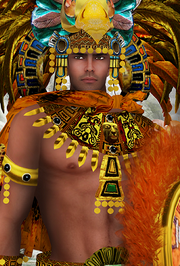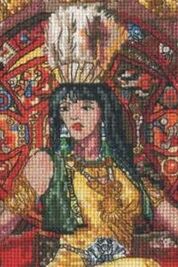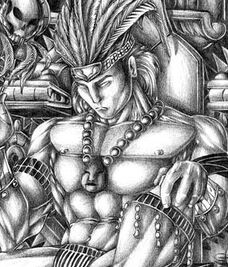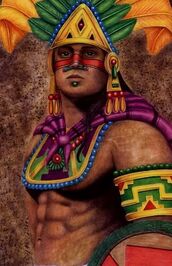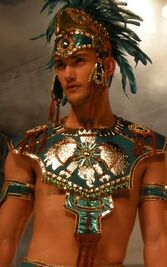| Emperor of the Aztec Empire | |
|---|---|
| Huey Tlatoani (Nahuatl) | |
Imperial | |
 Imperial Emblem | |
| Incumbent | |
 Quatzalzuma III since 2008 | |
| Details | |
| Style | His/Her Divine Majesty |
| Heir apparent | Ayaxatla |
| First monarch | Tenoch |
| Formation | 1325 |
| Residence | Palace of Tenochtitlan |
The Emperor of the Aztec Empire, formally titled the Emperor of the Aztec Triple Alliance, also called the Emperor of the Aztecs, also simply and commonly called the Aztec Emperor is the absolute monarch, the head of state, the head of government and the commander-in-chief of the Aztec Empire.
The Aztec Empire is an autocratic, absolute and hereditary monarchy. The emperor of the Aztec Empire is worshipped as a living god, son of the gods and supreme ruler of the empire. The emperor rules the nation with an iron fist. He and his family reside in the Palace of Tenochtitlan, in the heart of the city. The emperor has infallibility, inviolability and his word is law. His official title as emperor of the Aztec Empire is "His Divine Majesty the Almighty Emperor of the Aztec Triple Alliance". There have been multiple instances of a reigning empress, such as Atotoztli, Tenochzitza and Teotlalco. The current Aztec constitution officially allows women to ascend to the Aztec throne. The current emperor is Quatzalzuma III. He was crowned emperor in 2008. The emperor may appoint governors to exercize his will in the provinces. The emperor may appoint several individuals to arrange the matters of state and other things. The Kings of Texcoco and Tlacopan are advisors to the emperor and can influence and play a large role in the Aztec government. The Aztec Emperor lives in the luxurious Palace of Tenochtitlan. The Aztec Emperor may choose any woman to become one of his concubines. However, there can only be one empress.
Line of Succession[]
If the emperor does not name a successor then the first in line becomes emperor. Women are currently allowed to ascend to the throne. The constitution implements absolute cognatic primogeniture.
The line of succession is described below:
- 1. Oldest child.
- 2. Children from oldest to youngest.
- 3. Siblings of the emperor from oldest to youngest.
- 4. Consort of the emperor/empress.
- 5. Sisters of the emperor the oldest to youngest.
- 6. Grandchildren of the emperor from oldest to youngest.
- 7. Children of the siblings of the emperor from oldest to youngest.
- 8. Other relatives of the emperor.
List of emperors[]
! Reign |- | 1 | Tenoch | 1345-1375 |- | 2 | Acamapichtli | 1375-1395 |- | 3 | Huitzilíhuitl | 1395-1417 |- | 4 | Chimalpopoca | 1417-1427 |- | 5 | Itzcoatl | 1427-1440 |- | 6 | Montezuma I | 1440-1470 |- | 7 | Atotoztli | 1470-1486 |- | 8 | Ahuitzotl | 1486-1502 |- | 9 | Montezuma II | 1502-1546 |- | 10 | Tenochzitza | 1546-1615 |- | 11 | Quatzalzuma I | 1615-1653 |- | 12 | Teotlalco | 1653-1680 |- | 13 | Cotezuma I | 1680-1711 |- | 14 | Ayaxatl | 1711-1723 |- | 15 | Montezuma III | 1723-1750 |- | 16 | Cotezuma II | 1750-1768 |- | 17 | Quatzalzuma II | 1768-1813 |- | 18 | Tehuetzquititzin | 1813-1834 |- | 19 | Tesozuma I | 1834-1868 |- | 20 | Techotlalatzin | 1868-1902 |- | 21 | Ixtlilxochitl | 1902-1910 |- | 22 | Cotazuma III | 1910-1956 |- | 23 | Cacamatzin | 1956-1968 |- | 24 | Chichimecacihuatzin | 1968-1983 |- | 25 | Tesozuma II | 1983-2008 |- | 26 | Quatzalzuma III | 2008-present |}

